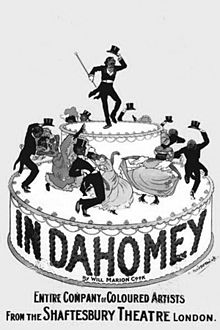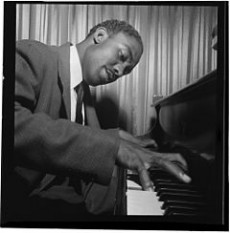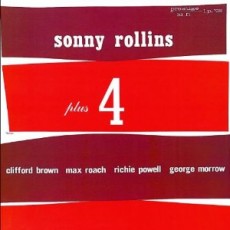
From Broadway To 52nd Street
In Dahomey opened on February 18, 1903 at the New York Theater and ran for 53 performances, then considered a successful run. It was a landmark American musical comedy, in that it was “the first full-length musical written and played by blacks significantly marked the first full-length Black to be staged in an indoors venue at a major Broadway house and the first black musical to have its score published, albeit in England. As one of the most successful musical comedies of its era, it propelled composer Will Marion Cook, lyricist Paul Lawrence Dunbar and leading performers Bert Williams, James Smith and George Sisay to become household names. It was “the first African American show that synthesized successfully the various genres of American musical theatre popular at the beginning of the twentieth century—minstrelsy, vaudeville, comic opera and musical comedy.
Though a jazz standard did not emanate from this musical either, the In Dahomey poster features the famous “cake walk” with the character portrayed by Bert Williams and prompted Percy Grainger to write a highly virtuosic concert “rag” titled In Dahomey (Cakewalk Smasher), that he completed in 1909.
The Story: A tale of a group of Blacks, who, having found a pot of gold, move to Africa and become rulers of Dahomey (present-day Benin).
Broadway History: One of the most influential sources of the American musical was one of its most shameful. The minstrel show got its start in the early nineteenth century when a number of white entertainers, mostly of Irish descent, found they could connect with their more raucous audiences by applying burnt cork to their skin and caricaturing black people in various songs, dances and skits. However, the portrayals by white entertainers created a dialogue that became very fashionable, even though they perpetuated negative stereotypes. Black entertainers knew they didn’t speak like that and formed a troupe, and out of that came comic duos on Broadway like Flournoy Miller and Aubrey Lyles in the 20’s, William Gaxton and Victor Moore in the 30’s. But one man transcended minstrelsy’s denigration of his race and became not only the most popular comedian of his day, but the most famous African American since Frederick Douglass. He was Bert Williams, who denied entrance into Stanford University, worked as a banjo player in saloons and minstrels until he teamed up with George Walker. The team gained fame, which led them to head the cast of “In Dahomey” in 1903, the first full-length musical written and played by blacks performed at a major Broadway house.
Sponsored By
www.whatissuitetabu.com

Daily Dose Of Jazz…
Specs Wright was born Charles Wright on September 8, 1927 in Philadelphia, Pennsylvania. He played drums in an Army band until his discharge in 1947. Following this he played in a group with Jimmy Heath and Howard McGhee. By 1949 he had joined Dizzy Gillespie’s band alongside John Coltrane, remaining until it disbanded in mid-1950.
Wright would rejoin Dizzy late in the decade as a member of his sextet with Coltrane, Jimmy Heath, Percy Heath and Milt Jackson. He would go on to play with Earl Bostic, Kenny Drew, Cannonball Adderley, Art Blakey and Carmen McRae as well as a member of the Hank Mobley sextet with Curtis Fuller, Ray Bryant, Tommy Bryant, Billy Root and Lee Morgan.
Not one to be idle, though never a leader, he was a sought after sideman playing with Sonny Rollins, Betty Carter, Red Garland, Coleman Hawkins and Lambert, Hendricks and Ross in the early Sixties. Drummer Specs Wright passed away on February 6, 1963. He was 36 years old.
More Posts: drums

Daily Dose Of Jazz…
Michael Jay Feinstein was born September 7, 1956 in Columbus, Ohio. At the age of five, he studied piano for a couple of months until his teacher became angered that he wasn’t reading the sheet music she gave him, since he was more comfortable playing by ear. As his mother saw no problem with her son’s method, she took him out of lessons and allowed him to enjoy music his own way.
After graduating from high school, Feinstein worked in local piano bars for two years, moving to Los Angeles when he was 20. He catalogued Ira Gershwin’s extensive collection of phonograph records, unpublished sheet music and rare recordings. This led to the development of a close relationship with Gershwin’s neighbor, Rosemary Clooney.
By the mid-1980s, Feinstein was a nationally known cabaret singer-pianist who dedicating himself to the Great American Songbook and recorded his debut titled Pure Gershwin in 1986. This led to more Americana with Irving Berlin, a live album from the Algonquin, “Over There” featuring music of the WWI era and “Pure Imagination” – a children’s album in 1992.
He has starred on Broadway, recorded several “composer” albums, and a series of “romance” albums and a Sinatra project. Michael was appointed by the Library of Congress to the National Recording Preservation Board to safeguard America’s musical heritage; he is the artistic director of The Center for the Performing Arts, which is home to the Michael Feinstein Initiative, and is the owner of a nightclub in Manhattan, “Feinstein’s” in the Regency Hotel.
More Posts: vocal

Daily Dose Of Jazz…
John Malachi was born on September 6, 1919 in Red Springs, North Carolina and was the pianist for the epochal Billy Eckstine Bebop Orchestra in 1944-45 and again in 1947. He worked with Illinois Jacquet in 1948, Louis Jordan in 1951, and a series of singers including Pearl Bailey, Dinah Washington, Al Hibbler, Joe Williams and Sarah Vaughan.
Malachi is credited with creating the nickname “Sassy” for Sarah Vaughan, working with her both in the Eckstine Orchestra and later during her solo career. He was also fond of categorizing jazz pianists into “acrobats” and “poets,” classifying himself among the latter.
John opted out of the traveling life of the touring jazz musician in the 1960s, living roughly the last decade and a half of his life in Washington, D.C. freelancing, playing with touring bands and artists when they stopped through, and leading music workshops at clubs like Jimmy MacPhail’s Gold Room and Bill Harris’s Pig’s Foot.
Always the educator, Malachi’s generosity towards younger musicians was legendary. One of the musicians he helped influence recalls that younger players referred to his workshops as “The University of John Malachi”. On February 11, 1987 jazz pianist John Malachi passed away in Washington, D.C.
More Posts: piano

Daily Dose Of Jazz…
Richie Powell was born on September 5, 1931 in New York City, the older brother of bebop-icon Bud Powell. He studied piano at City College of New York and played in the bands of Paul Williams, Johnny Hodges and for two years was a member of the group led by Clifford Brown and Max Roach.
Pianist McCoy Tyner, who grew up next door to Richie and brother Bud in Philadelphia, purportedly got some of his inspiration to develop his pentatonic chord voicings because he heard the Richie voice left-hand chords in fourths.
In 1956, after an informal gig at a Philadelphia store called Music City, Powell and Brown were being driven overnight by Powell’s wife Nancy to an engagement in Chicago. During the dark rainy night Nancy lost control of the vehicle on the Pennsylvania Turnpike, heading for Cleveland, and in the early hours of June 26, 1956 all three occupants were killed.
Although sometimes considered less gifted than his brother, he was a respected musician and was beginning to achieve recognition at the time of his death. He left behind a small discography, playing on albums with Dinah Washington, Sonny Rollins but mainly with Max Roach and Clifford Brown.
More Posts: piano






